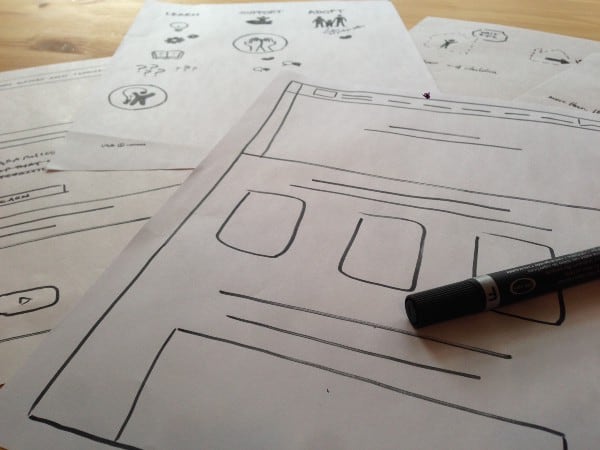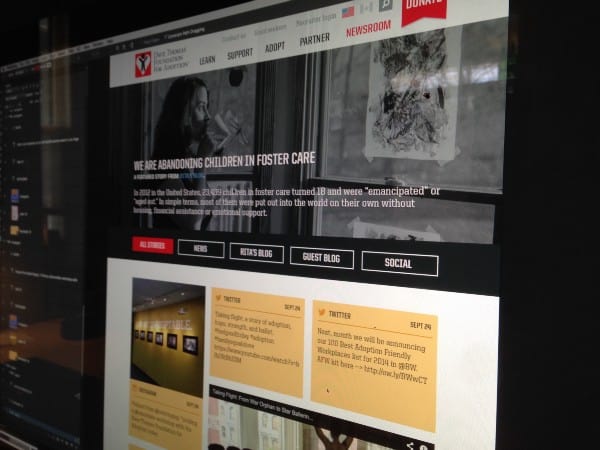Well, this is it: The last post in our guide. We hope you’ve used these four weeks to work through a brand new set of skills with your team and are having fun using it to bring a new innovative idea to life. We live and breathe this process every day and we wouldn’t do it if we didn’t believe in it. And love it. So thanks for coming along with us.
And now, even as the process itself is wrapping up, we want to help you round-out the time and keep your team looking towards the future. It’s important to keep things moving, so we’ll take a look at how to keep the momentum up, and what it’s going to take to chart a path towards a Pilot.
Debrief
In this last week, it’s a great time for a little bit of team reflection. Remember, when we first started, we were refining a problem, onboarding your team, and setting up tools in preparation for Week 1. Now, we’ll do the reverse: reflecting on the problem, off-boarding the team, and thinking about how the tools worked. The ultimate goal is to better understand what it all means as we move past Week 4.
As you debrief with your team, set some goals. Whether it’s a “retrospective meeting” you put on everyone’s calendars or some informal discussions, focus the conversation on these themes:
Celebrate successes and document how to repeat them. Discuss problems and how to grow from them.Reflect
on any important team detailsand document the key takeawaysfor addition to your Roadmap.Discuss next steps andwork with the team to set expectations on follow-up tasks, deciding who is responsible for what actions.
Tip: Keep a set of notes for yourself including logistical details that come up. “That color of Post-it Notes were amazing!” or “We really needed a different kind of personality to play role X in that prototype.” These little details are easy to forget, but will be so helpful to remember next time. So jot ’em down.
And don’t forget, this is your team’s time to really show the value of what you’ve accomplished, so keep the compliments coming and the energy high! You’ve all worked really hard, and everyone deserves to feel appreciated, so don’t end the time without a good team praise session. ??
Funding Innovation
If your Roadmap plan is to take next steps with the innovation, regardless of whether you have capacity to do it or need to seek outside partners, you’ll need to make a case for funding. Sure, it can feel hard to talk about money sometimes, but the reality is that funding is going to play a big part in where and how you move forward. Whether you’re a for-profit or non-profit, start by looking for funding in your typical places. Maybe you can get creative with existing budgets inside your organization or you’re lucky enough to be able to pursue entirely new funding sources. No matter what, we’ve all lived the reality that sometimes (OK, many times) the amount of money left in the piggy bank is not enough to do what needs to be done. What do you do then?
Sometimes, the realities of seeking funding for innovation is going to be more about thinking about things as a cost/benefit conversation. In other words, it’s time to make the business case. Just as great ideas needs to be proven as you prototype, they also need to be proven in how they can grow and scale. This again is where the Roadmap plays a big part.
If you have investors, many will be interested in how your work can positively affect growth; They will want to see that vision clearly. Or if you don’t have investors, it’s all about talking through implications for reallocating budgets or going out to find funding to support next steps. Whatever your prospects, it’s important in this time to speak the language. Focus on explaining your work in terms of costs and benefits, competitive advantage, differentiation, growth and scale. This may mean that you’re using terms that we’ve held close all along like “innovation,” “creativity,” and “trying new things” a little less, but that doesn’t change the spirit of your work. Stay innovative! Stay creative! But just like the spirit of empathy in your process towards those who you’re serving, if we want to see this innovation in people’s hands, we have to make the business case in business terms. This step is all about using the realities of the situation to your best advantage. It’s an important step to getting your innovation out there.
In the end, innovation that never ships is just invention, and inventions that people never use are just experiments.
While we’re talking about shipping, continue the funding conversation and get a gut check from the team. It’s important to be realistic with your goals. In other words, don’t seek a bazillion dollars to fund a huge team working for the next five years. Instead, go after enough funding to get you to a solid Pilot, keeping the team and resourcing nimble, so that you can prove it at a scale that will naturally turn heads and lead to healthy next steps. If you do it right, more funding will be just on the horizon.


Getting to Pilot
OK, now that we’re officially real-deal adults talking money and business, let’s keep going and talk about how to run your Pilot. Wait… what’s a Pilot?
A Pilot is about setting up a scenario for you to run a real-world test of your ideas without fully taking them to market. Basically, if a prototype is a test of your innovation, a Pilot is a longer-term rollout of those ideas. It could last for months, and during this time you’ll be fully testing what your product could be in the hands of real people. Then, if it is successful, you have a proof of concept that has proven your ideas can really work.
When doing this kind of work, there are several key things to do to make the plan successful. Let’s talk about the things we’ve leaned over the years that we always bake into our Pilot process.
1. Dedicate time, and time box it.
This is maybe the easiest thing you can do, and we’ve found it to be a key to success during this phase. It’s important to give your innovative ideas the room to succeed, and that’s going to require you to dedicate the correct amount of time to run the test, and to include a healthy buffer for things to go less than perfect (as they often do).
For example, let’s say you’ve picked a 12 week timeline. When week 13 comes along, the temptation is to continue looking for success by blindly continuing the Pilot if you haven’t found the results you wanted. In some cases that could be the correct response (we’ll talk about in the last point in this section), but more often, we’ve found that what you now need to do is pivot if you aren’t seeing the results you were expecting. Allowing the necessity of a time-box will give incentive to success and a reason to stop and ask some tough questions if success hasn’t come yet. Focus on that key word: pivot.
2. Dedicate resources (team, money and tools).
Similar to a dedicated time-box, a dedicated set of resources is going to be key. Be sure to empower a lead (or co-leads) to own the Pilot, and agree upon needed roles and assign them to members of your team (or your new larger Pilot team).
Before the beginning of the Pilot, make sure the needed funding is there and set a budget, including financial goals, that will be needed to run the Pilot plan and purchase any needed tools. In short, don’t treat the Pilot as anything less than a real project within your organization.
3. Be willing to accept the results.
This one is really, really important. It’s going to be so tempting to try to align the results of a Pilot with the results you want to hear. We’ve all done it. It’s so hard to look at the situation honestly, but its so important to try. If the Pilot fails, let it fail. That’s OK. Similarly, if it succeeds, keep in mind that it is just one test. In both situations, a tempered response is key. Keep in mind:
The Pilot is a dedicated time of learning, not a point of finalization.
Around these ideas of expectations and reality, we sometimes call the urge to bring our opinions into the mix our “bias.” While this concept is similar to a hunch (and should be listened to), calling these feelings is an opportunity to look at them with a healthy dose of scrutiny. So while our biases lead to our hunches, keeping an open mind and being willing to learn and grow via proving tests (rather than assumptions) is how to move forward. There’s not a magic guide to mastering the difference — the best way to hone this is with practice! So dig into the Pilot with an open mind and a willingness to accept what comes, not what you expect to come.
4. Document the process and takeaways.
This is a friendly reminder to keep housekeeping tasks like documentation not for the end of the Pilot, but throughout. Give this task a role if needed, or encourage everyone involved to be documenting as they learn. These takeaways will be crucial for after the Pilot, and can help judge growth or change in the Pilot as it progresses.
5. Repeat the Pilot, with variations as needed.
Like we mentioned above, the idea of repeating the Pilot is on the table at the end of any Pilot session, but this is something that should be thought of carefully. Typically we find a repeated Pilot is only most helpful when testing again for specific features with a renewed focus on those areas. For example, if the cost of your program was seen to be inconclusive, run the exact same pilot again with an updated financial structure. Treat the pilot like a science experiment, repeating it carefully and thinking of variables and how to modify them.
Final Wrap-Up:
Building a Culture of Innovation
Alright folks, that’s it! It’s been four weeks that we hope have brought a new culture of thinking to your team and has encouraged you to start thinking about problem solving in a fresh, new, people-first way.
And truly, our ultimate goal with this guide is to help spur a culture of innovation within you and your organization. Done once is great, but this guide and the concepts we discussed used again and again can build a culture where these ideas can become the standard. And that’s when things get really interesting. When everyone from your CEO to your interns are thinking about innovation first, your projects will see better success, shorter cycles, and better outcomes. We know this because we’ve watched it happen and believe in it — for others just as much as we’ve seen with ourselves.
So get out there and do this again! You can do it.

